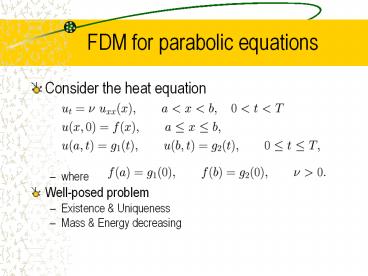FDM for parabolic equations PowerPoint PPT Presentation
1 / 36
Title: FDM for parabolic equations
1
FDM for parabolic equations
- Consider the heat equation
- where
- Well-posed problem
- Existence Uniqueness
- Mass Energy decreasing
2
FDM for parabolic equations
3
CNFD
- Crank-Nicolson 2nd order finite difference
- Questions
- How to solve the equations efficiently???
- Convergence and order of accuracy???
- Local truncation error Stability
4
Local truncation error
5
Linear system
- Order of accuracy 2nd in space and time
- Consistency yes!!!
- Linear system
- With
- Implicit scheme!!!
- At each time step, we need solve a linear system
6
Matrix form
7
Solution algorithm
8
Convergence analysis
- Convergence
- Consistency Stability
- Consider the general problem
- It is a well-posed problem
- Existence, uniqueness, continuously depend on
initial data
9
Finite difference discretization
- Time step
- Mesh size
- Index set of grid points
- Exact solution at level n
- Exact solution vector at level n on grid points
- FDM approximation vector at level n
- Norms
- Maximum norm
- 2-norm
10
Finite difference discretization
- General form of finite difference scheme
- Assume B1 is invertible, i.e. its representing
matrix is non-singular - Formally it represents the differential equation
in the limit - Uniformly well-conditioned
11
Convergence analysis
- Truncation error
- Consistency
- Order of accuracy p-th order in time q-th
order in space - Convergence
- Order of convergence p-th order in time q-th
order in space - Stability
- two solutions have the same inhomogeneous terms
but start with difference initial data
12
Convergence analysis
- Stability condition
- von Neumann method based on Fourier transform
- Energy method
- Lax Equivalence Theorem For a consistent
difference approximation to a well-posed linear
evolutionary problem, which is uniformly
well-conditioned, the stability of the scheme is
necessary and sufficient for the convergence. - Proof See details in class or as an exercise!!
13
Von Neumann method for stability
14
For CNFD
- Plugging into CNFD
- Amplification factor
- Unconditionally stableno constraint for time
step!!!!! - Energy method See details in class or as an
exercise!!
15
Convergence analysis
- Convergence of CNFD
- Consistency
- Unconditionally stable
- From Lax equivalent theorem implies
convergence!!! - Convergence rate
- Other methods for analysis
- Energy method -- Exercise!!
- Based on maximum principle Exercise!!
16
Method of line approach
- Discretize in space first
17
Method of line approach
18
Method of line approach
- An ODE system
- Discretize in time by ODE solver
- Trapezoidal method
- Forward Euler method
- Backward Euler method
- Runge-Kutta method, ..
19
Method of line approach
- Discretize in time first
20
Method of linear approach
- Discretize in space by finite difference
- This is CNFD
- Other discretization in space is possible
21
Other discrtization for heat equation
- Forward Euler finite difference method
- Local truncation error
- Explicit method direct marching in time
- Consistency yes!!
- Stability condition
- Under stability condition, it converges
22
Other discrtization for heat equation
- Backward Euler finite difference method
- Local truncation error
- Implicit method
- At each step, the linear system can be solved by
Thomas algorithm - Consistency yes!!
- Unconditionally stable!!!
- It converges and has convergence rate
23
Extension
- For Neumann BC
- Discretization CNFD
24
Extension
- Local truncation error 2nd order in space
time - Consistency yes!!
- Implicit method
- Linear system -- exercise
- Matrix form exercise
- Stability unconditionally stable!!
- Convergence
25
Extension
- Variable coefficients
- Discretization -- CNFD
26
Extension
- Local truncation error 2nd order in space
time - Consistency yes!!
- Implicit method
- Linear system -- exercise
- Matrix form exercise
- Stability unconditionally stable!!
- Convergence
27
Extension
- 2D heat equation
- Discretization
- Crank-Nicolson in time
- Second order central difference in space
28
Discretization
29
Extension
- Local truncation error 2nd order in space
time - Consistency yes!!
- Implicit method
- Linear system At every step, use direct Poisson
solver - Matrix form exercise
- Stability unconditionally stable!!
- Convergence
30
More topics
- With Rabin or periodic BCs
- 2D heat equation in a disk or a shell
- 3D heat equation in a box, spehere, .
- More general case
- ADI (alternating direction implicit) for 2D 3D
- Compact scheme
- Nonlinear equation system of heat equations
31
Nonlinear parabolic PDEs
- Allen-Cahn equation
- Applications
- Imaging science
- Materials science
- Geometry,
32
Numerical methods
- Standard finite difference methods
- Crank-Nicolson finite difference
- Forward Euler finite difference
- Backward Euler finite difference
- Special techniques
- Time-splitting (split-step) method
- Implicit-explicit method
- Integration factor method
33
Time-splitting method
- From , apply time-splitting technique
- Step 1. Solve nonlinear ODE for
half-stepintegrate exact!!! - Step 2. Solve a linear PDE for one step-- CNFD
- Step 3. Solve nonlinear ODE for half-step
Integrate exact!!!! - Accuracy in time second order!!!!
- No need to solve nonlinear system!!!!
34
Implicit-explicit method
- Ideas
- Implicit for linear terms Explicit for
nonlinear terms - Discretization
- Method 1 for computing dynamics
- Method 2 Convex-concave splitting
- Method 3 for computing steady state
35
Integrate factor (IF) method
- Rewrite
- Multiply both side
- Integrating over
- Approximate in time via RK4 in space via FDM
36
Nonlinear parabolic PDEs
- Sharp interface
- Ginzburg-Landau equation (GLE)
- General nonlinearity
- System,.......
- Compact scheme in space

